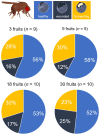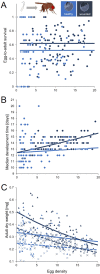Resource use by individual Drosophila suzukii reveals a flexible preference for oviposition into healthy fruits
- PMID: 32081929
- PMCID: PMC7035383
- DOI: 10.1038/s41598-020-59595-y
Resource use by individual Drosophila suzukii reveals a flexible preference for oviposition into healthy fruits
Abstract
The invasive pest fruit fly Drosophila suzukii is thought to be a specialist on healthy, i.e. unwounded, non-fermenting fruits. Morphological (sharp ovipositor) and neurophysiological/behavioural adaptations have been suggested to contribute to distinct adult feeding (wounded/microbe-laden fruits) and reproductive (healthy fruits) sites. We tested whether (1) variation in the overall availability of fruits, (2) variation in fruit type (healthy, wounded, fermenting), and (3) the relative abundance of different fruit types are ecological determinants of D. suzukii egg-laying decisions. Even though individual flies reduced their reproductive output when resource availability (blueberries) was low, a significantly higher proportion of eggs was allocated to healthy fruits, relative to wounded and fermenting fruits. However, the preference for healthy over wounded fruits declined continuously with a decrease in the relative abundance of healthy fruits and the overall reproductive output did not change. Under laboratory conditions, D. suzukii larvae achieved a higher developmental success on wounded than on healthy blueberries, but suffered less from density-dependent competition in healthy fruits. These data suggest that D. suzukii, despite showing an egg-laying preference for healthy fruits, also uses wounded/fermenting fruits as egg-laying sites, and that it may thrive well in windfall fruits.
Conflict of interest statement
The authors declare no competing interests.
Figures





References
-
- Plantamp C, Estragnat V, Fellous S, Desouhant E, Gibert P. Where and what to feed? Differential effects on fecundity and longevity in the invasive Drosophila suzukii. Basic Appl. Ecol. 2017;19:56–66. doi: 10.1016/j.baae.2016.10.005. - DOI
-
- Scheirs J, De Bruyn L. Integrating optimal foraging and optimal oviposition theory in plant-insect research. Oikos. 2002;96:187–191. doi: 10.1034/j.1600-0706.2002.960121.x. - DOI
MeSH terms
LinkOut - more resources
Full Text Sources
Molecular Biology Databases

